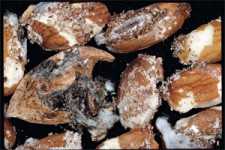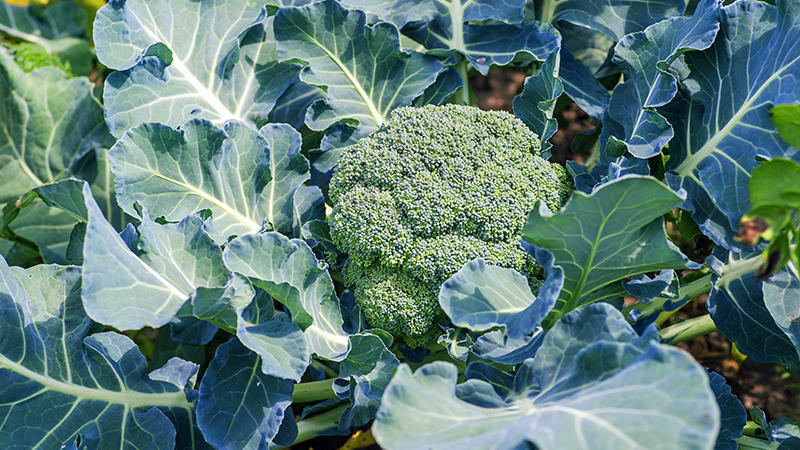Navel Orangeworm Control Needed

Navel orangeworm (NOW) is the major pest of almond production in California. Damage to nuts from this pest can cost growers from a few dollars to hundreds of dollars per acre depending on the level of damage and total yield. NOW damage also increases the market risk for the entire California almond industry.
Aflatoxin levels in kernels increase with NOW damage. The European Union (EU) — a third of the entire market for California almonds — is very aware of aflatoxin risk and has put the California almond industry on notice that efforts must be made to ensure that aflatoxin contamination of almonds remains below their standards. At the same time, the EU wants almond production to be more sustainable, so there is also market pressure to move away from broad spectrum pesticides like pyrethroids to softer practices such as mating disruption and lower environmental risk pesticides.
A comprehensive study on new approaches to NOW control is just being completed in its fifth and final year in California. This is a USDA-Agricultural Research Service project, funded by the federal government, with additional support from the almond, walnut, and pistachio industries. USDA, University of California, private researchers, and pest control advisers are doing the work. This article is a brief
review of NOW management research and practices in almonds presented at an overall project meeting held in Parlier in September.
Overall Plan
The NOW population in an orchard can build rapidly from spring to fall without grower action. There are typically three complete generations of NOW annually in California orchards. Female NOW can lay almost 100 eggs in a lifetime. NOW are strong fliers and can move from one orchard to another. Achieving total NOW control in an orchard is difficult. Key to effective NOW management is reducing the population as much as possible at vulnerable times in the NOW seasonal cycle through cultural and, if necessary, chemical means.
NOW overwinters in mummy nuts in the orchard, and mummy fruits and nuts on trees in the surrounding area. Adult moths emerge in the spring and lay eggs on mummy nuts. NOW feeds on mummies until hull split in the summer when new crop nuts — a better food source — attract egg-laying females. The NOW population increases rapidly with this new food source. NOW requires fewer degree days (DD) per generation when feeding on new crop almonds (roughly 750 to 800 DD) compared to feeding on mummies (roughly 1,050 to 1,100 DD).
The Nonpareil hull split spray protects those valuable nuts, but it also decreases the entire NOW population, reducing the risk of damage to the late-harvested pollinizers like Monterey. With soft pesticides (low risk for flaring mites and a short preharvest interval) now commercially available, some San Joaquin Valley growers with high NOW pressure have moved to a three-spray program (May, hull split, and post hull split) to try to suppress the NOW population to low levels. Sacramento Valley growers will not usually need more than a May or hull split spray depending on year, spray coverage, and proximity to other sources of potential NOW infestation such as nearby unmanaged orchards.
Orchard Sanitation
This key practice remains the foundation of any NOW management program. In the northern San Joaquin Valley and Sacramento Valley, the established target level of mummy nuts in the canopy as of Feb. 1 is two mummies per tree. In orchards where more than that level is found, knock mummies from the trees using harvesters or poling by hand. All mummies on the orchard floor should be destroyed (mowing, discing, etc.) by March 15. A new target of less than one mummy in two trees (average of 0.5 mummies per tree canopy) and an average of four ground mummies beneath each has been suggested for Kern County orchards. View the research article on this topic at: http://ucanr.org/u.cfm?ids=2281.
In many years and in many locations — especially in the Sacramento Valley — Mother Nature (birds, rodents, and winter storms) virtually eliminates mummy nuts in almond orchards by the end of winter, and no sanitation efforts are needed by the grower. However, it is always good to monitor mummies every winter and remove them if necessary to make sure that the NOW populations are as low as possible to start the season. Natural mummy fall may not be as great during dry winters, and orchard sanitation may be needed under those conditions.
Mating Disruption
Mating disruption (MD) work in large (thousands of acres) blocks in the San Joaquin Valley shows that the combination of two NOW pheromone puffers/acre and “soft” pesticides can keep NOW pressure and damage at very low levels. These orchards were high-pressure sites before the study and were “cleaned up” with a rigorous pesticide program, including pyrethroids, before the MD study began. Insecticides directed at NOW have been reduced 80% to 95% since the MD program was implemented.
Efforts to achieve the same control with one NOW puffer per acre or a shorter pheromone “season” (both with insecticide applications as needed) have not, to date, been as successful as the two puffer per acre program plus insecticide in high-pressure sites. However, there has been success using MD with 1 or 1.5 puffers per acre in low- to moderate-pressure sites, both with and without additional insecticide treatments for NOW. Careful, regular monitoring of NOW population — using egg traps now and pheromone and egg traps in the future — is key to effective use of pheromone for NOW control. The monitoring results are used to determine if pesticides should be used to supplement the pheromone.
MD can work, but needs careful monitoring and large-scale cooperation between neighbors to work well across an entire area. Upwind portions of an MD block can have high NOW damage at harvest if neighboring blocks have high pressure. MD is not a stand-alone practice under high NOW pressure.
Does it pay to use MD? If your processor follows an incentive program and rewards very low levels of nut damage with extra payments, then, in some years, in areas where NOW are treated each year, MD can pay for itself. When pressure is high, carefully managed MD can save enough in damage and quality incentives to more than pay for the additional cost of the pheromone and puffers.
Insecticide Efficacy
New pesticide chemistries — Intrepid (Dow AgroSciences), Altacor (DuPont Crop Protection), Delegate (Dow AgroSciences), Belt (Bayer CropScience), etc. — can kill NOW eggs or larvae as effectively as pyrethroids. Some of the new chemistries have activity on adults as well. Coverage is the big challenge with these new materials. Research continues to improve NOW control from newer pesticide chemistries to 1) manage pesticide resistance, 2) avoid late-season spider mite outbreaks, and 3) work to meet market demands for more sustainable pest management. Finally, pyrethroids are extremely toxic to fish at levels as low as 1 part per billion. Alternatives to pyrethroids may be needed if regulation limits the use of this popular pesticide chemistry.
Spray Coverage
Regardless of the pesticide in the spray tank, spray coverage makes a huge difference in NOW control. Field tests showed that spray coverage and NOW control decreased from 10 feet to 16 feet-plus in the tree canopy using conventional (axial fan) airblast sprayers. Poor spray coverage and lower NOW control occurred in the upper quarter of almond tree canopies compared with the lower canopy. Slow tractor speed (2 miles per hour) and higher spray volume (200 gallons per acre) provided the best NOW control in studies in the San Joaquin Valley. Work to improve pesticide spray coverage is continuing in the Sacramento and San Joaquin valleys.
NOW Monitoring
Ten to 15 NOW egg traps per orchard are needed to accurately detect NOW infestation when the population is low — as often is the case in the crucial spring period. A single trap in an orchard could be worse than no information at all. No eggs in a single egg trap in an orchard could lull a PCA or grower into thinking there is no pressure when there actually is light pressure that requires multiple traps to have any chance of early season detection (egg catches). More traps also provide a more accurate biofix date to initiate the degree-day model. Strategic placement (distributed nearly equally on edges and interiors plus known hotspots) of these traps has been demonstrated to be the most effective approach, and has provided information that contributed to successful management of both mating disruption and conventional insecticide-based programs. Differences in trap bait materials are far less important than the number of traps in effective pest monitoring.
NOW Pheromone Trap
An effective pheromone trap has been developed and tested over the past year. Some further refinements may need to be made; for instance, it is not clear whether a three- or four-component blend will be the most effective in all nut crops. A commercially available lure should be available in the next one to two years. When available, this lure will be a great addition to assist in monitoring and managing NOW populations. For now, growers and PCAs must use multiple egg traps to track NOW populations.










